The Last Federation by Arcen Games is an interesting and even bizarre mix of genres and styles. This is not uncommon from a developer who tends to think outside of the box and mix genres in unique ways. It can be a merit and a flaw at the same time, but it does certainly lead to a unique or at the very least a novel experience; even if one does not enjoy their games they may still find interesting ideas within them. In addition, the developer offers a lot of post-release support.
The end result is that TLF is a unique and even an enjoyable experience as the player is presented by many options but is limited to influence things from the shadows which can lead to interesting results. The developers’ continued support ensures that common issues are resolved quickly and unpopular gameplay mechanics are revised, however, it also means the balance can shift quickly and not always in a way the player will approve.
For the purpose of the review I will look at the current build of the game and focus more on elements that are more constant. I will, however, mention when some of these changes had a significant shift in experience.
In a nutshell, The Last Federation is a blend of many Grand Strategy and 4X elements that is played on a pauseable real-time map (actually the game is paused by default and requires an action or deliberate choice to lapse time forward), mixed with a turn-based (plan phase and short real-time execute phase approach) that plays more like a stop-motion turn-based arcade shoot-em-up. The player also plays a single character that acts like a powerbroker and mercenary that influences the other factions in the game.
The Basics
The game unfolds in a fictional setting where a race known as the Hydral maintained a monopoly on space travel effectively keeping the other races of their star system down. This eventually back fires which results in the extermination of the Hydral race, you being a pioneer of a new thought: “creating a Federation to unite the star system”; but this goes unheeded by your peers until it is too late. Surprisingly the extermination of your race does not deter you from your goal to still carry out your objective.
This federation-uniting goal is your in-game objective, unlike the usual of conquering or allying all the factions, as you tend to see in other strategy games of the sort. Here you attempt to form a federation from scratch and then help this Federation absorb or eliminate the races that did not join. The game focuses on this approach of giving you your final goal, but letting the player choose how to get there and whatever side objectives they give to themselves. The player can choose to eliminate a certain race or go above and beyond the call of duty to keep another race alive. The game’s achievement system rewards several of these combinations to victory.
The games’ options are rich. The player can select everything from the difficulty level of space battles separately from the strategic difficulty level, select which race captures you (affects who has space travel at the start and what your ship will be), enable ironman mode, and even allow for death in combat ,which when enabled with ironman mode can make the easier difficulties more challenging. The game also offers a basic tutorial that teaches the player through pop-up windows, and game features are disabled until they are explained. However, even with the tutorials the game can take quite a bit to get into as there are a lot of options, differences on how you deal with each race, and the way things can butterfly-effect are numerous.
The game also offers a simulation mode, since the core element of the game is more of a simulation-based strategy game. In this simulation mode you don’t exist and just watch how the star system evolves without your presence.
The amount of selection is welcomed as it allows the player to customize their experience more. Though the player has no control over the setting itself, the options given are most certainly welcomed, especially separating the difficulty of combat and strategy from each other.
The game is set in a single star system with the planets being the same. Visually though, the map will place them in different locations and each will have different values. Also, which race starts on which world is also randomized. This can significantly impact which race will have an easier time to dominate, and can lead to extreme results, making so that even if the player does not change his strategy the game will evolve differently.
The game’s graphics seem to be a 2D sprite-based art using parallax techniques to create visual depth. The art work is of high quality, which is important as this will be the bulk of the visual presentation the game will offer and even act as a reference point as the player navigates this menu driven game. The game’s music is definitely enjoyable to listen to and the player’s ship AI is voiced by a snarky and sarcastic personality who keeps the player updated about the more significant events.
Combat
The preview upon release covered the basics of the combat mechanics. As mentioned, it is turn-based but not in the traditional sense. A few games have taken this approach however, the system involves giving your unit its orders for the upcoming execute phase, and then a short amount of time lapses in real-time as your orders for that period are carried out. Rinse and repeat.
This combat system is not new, but it is certainly interesting as it is not common, and games that have used it proved to be interesting additions to the strategy genre. What is more unique about TLF is that you only control one ship, and the overall combat mechanics are more reminiscent to old-style arcade shoot-em-ups. This makes combat interesting and further highlights the aspect that you are just one Hydral. However, it may not be what many consider a true tactical combat system.
Despite the more shoot-em-up aspect of combat, there is still a considerable amount of tactical choice available. The player can regulate their power distribution, designate targets and plot their movement course to avoid the incoming fire. Also, the player’s vessels hold a set of special modules like special weapons and cloaks, while the player will also have access to several weapon systems and be able to select three to use in combat.
Since the battles tend to pit the player against overwhelming odds, the focus of combat is to achieve the mission objective. This does result in an interesting tactical play; however, since the focus will mostly be shooting down targets as you avoid predictable swathes of enemy fire leaves, this ultimately plays out more like a shoot-em-up. So, it might not be what many are looking for when it comes to tactical play.
One major flaw with combat is that it can get very repetitive very fast even if you like the style. This is sometimes stressed when you find a ‘loop-hole’ that lets you grind or farm a certain action. But, even without this, the combat can get repetitive as most of the battles tend to follow the same pattern. The developers do address the grind tactics by removing the element that makes them so tempting to be farmed. This indirectly might make achieving certain objectives in the strategic layer more difficult.
The game offers an auto-resolve option for those that prefer to focus more on the strategic play. Overall, this does seem to work quite well to bypass the combat part, but tends to not always work. There are missions like hunting down anti-Federation Insurgents which the auto-resolve will not factor you destroying the orbitals and only the ships. There are also a few actions that you can’t auto-resolve and the player will need to play them out on their own. One thing that did stand out, is that you can select when to auto-resolve, even after you engaged in battle for a few turns manually first.
The Strategic Layer
The game’s main focus is the actions done in the strategic layer. However, this is more of a scheming layer as you proceed through the game. The player will have an assortment of actions they can do, both hostile and ‘beneficial’. This can range from blowing up planetary improvements, stealing techs, gathering blackmail, smuggling resistance fighters, to hunting pirates, smugglers, attacking anti-Federation protesters, helping develop a world, and help research techs.
The list of actions may seem limitless as you can also lease-out captured outposts and perform tasks like cleaning up the local orbit of space junk to mining undeveloped moons. Sabotage relations or help them develop them, frame other races for conspiracies, and even attacking trading lanes or disrupting the local government. These actions can help generate income, while others will cost credits to enact. Many of the more hostile and disruptive actions require having a broker implanted on the planet. Most races are susceptible to this but two are immune to this criminal element which will make them harder to scheme against.
Overall, the amount of choice and effects the player has at their disposal makes for a solid diplomatic and espionage gameplay. It is a shame that more games do not offer the players this much choice, but then this is the primary focus and way to influence a star system in The Last Federation.
This is one of the key features and probably also the most interesting one, each race is different from each other. Though many of the core actions are the same, once you reach the political actions you have to deal with each race uniquely. They also have unique abilities themselves to influence other races. Learning how to use these abilities is one of the larger challenges of the game, and can lead to interesting options and entertaining results.
For example, one race is good at meddling into the affairs of other races usually in a beneficial way if your goal is peace and prosperity. However, which actions this race can take is based on which faction is in charge, so you will have to influence the local politics to get the group you desire in power to be able to gain access to the ability you want to exploit. Another race can perform surprising actions like dumping toxic waste on another planet, but will also require that the correct CEO be one of the three in charge of running that planet.
Generally the use of currency is used to pay for actions, so just getting the right people in power is not enough, you have to afford the favours as well. Some races do not value money though; favours are gathered by using leverage or votes with that race. This introduces another mechanic the player needs to manage as they attempt to gain the ability to influence those races as well.
The game captures the essence of being a powerbroker quite well, as you contemplate your next move, and factor in what each race can do for you and do to each other as you try to achieve your goals. However, this can be daunting too as you play the game for the first few times as some of these options are not immediately apparent, and you will shoot yourself in the foot by burning a bridge too soon.
Overall, if you love playing strategy games by being the one that influences things behind the scenes this game captures it very well. However, if you are more into direct intervention, then the game will be less interesting. This doesn’t mean there aren’t actions you can’t do directly, but the bulk of your achievements will come more from pulling things off through a domino effect than directly influencing the outcomes.
About the Interface
Since a lot of the game’s actions are handled by the menus, it is important to cover this separately. Overall, the game’s user interface gets the job done. It is easy to navigate from one menu to the other and each aspect of the game is accessible from the main UI. The player also has access to many graphs and tables that show useful information like: the number of fleets, techs, current wars, and graphs for population and other variables.
Usually, the ability to get information or changing the load-out of your ship for combat is just a button away. The UI is also good at relying information back to the player. For example, choosing to raid a trade route will show you just how much you will annoy the other factions as well. When an option is not available, it will clearly show what the player is missing to achieve it. Every action will have its effects listed. Considering the amount of information that is thrown at you, it is good that the game informs the player this well.
The game does throw a lot of information to the player that goes looking for it; sometimes many of these figures don’t seem immediately useful but fortunately it is accessed from secondary screens and is not thrown at the player immediately. One improvement the developers have addressed in their updates was to bring certain critical information elements to the main screen, like ground power strength, which makes understanding why a planetary invasion is not working more apparent.
The one flaw the UI does have is that sometimes it is not entirely intuitive. As mentioned before, many races have different mechanics and options associated with them in their political dealings. This also means that some options that are indeed common between races are not exactly in the same place, meaning that the player has to learn the layout of each race’s politics screen separately. This is one area that could have been handled better.
A Simulation at its Core
The simulation aspect of the game does act against it at times as it reduces the player’s sense of involvement in the game, and unlike in other strategy games where a player chooses to wait to allow for a better strategy to come into play, or takes steps leading up to a major pay-off, in TLF the player will have to wait to let the universe flow past them. Despite the fact the game offers actions that lets you do something while time lapses, it feels like the game is playing by itself during these times.
The other element that tends to act against the game regarding the simulation aspect, is that many times it feels the player will only have a small impact on things. This sometimes proves interesting at first as you try to figure out the pebble drop that will create the tsunami. But, it can be frustrating when you can’t seem to figure out the situation, and every action you try to do is undermined easily by the somewhat precautions nature of some of the trends that occur naturally in the game. So, sometimes, the game forces the player to sit back and let the whole thing just play out by itself until the opportunity arises for the player to have an impact again.
Two common examples that illustrate this: the first is the ability to help races, which improves their relations with each other; and the other is the resistance of war-like races.
Regarding helping other races, the player can only very slowly, and up to a certain limit, improve the relations between races directly. Many times in the game you will have a potential prospect that you wish to enlist into the Federation but be left with very little options to encourage it from happening. You will quickly exhaust options like making them trading partners and allies against a common foe, and still be ways away from achieving their enlistment. Realizing that the slow process of increasing their relations to each other is capped on your end just adds to the frustration. There has even been a build where the value was so high that it was literally impossible to achieve it at times, fortunately the more recent builds have toned this down considerably.
Though special political actions can help improve relations, they are not always available as they too tend to have somewhat persnickety limits like being above a certain level of relations, having a certain political party in power, or having a certain Prime in charge. The player can influence many of these, but sometimes many seem to be just equally random in their results, and many cost a lot of credits to enact.
The other culprit, in what player frustration is concerned, is the war-like races, especially if you go the route of uniting the more cooperative races first. Often times you will find that one of the two, if not both of the masters of ground warfare, will be against you. You can unite all the other races, have them be three times more technologically advanced, practically obliterate their space force, and still be unable to eliminate them. You will spend the rest of the game quarantining their world, trying to encourage the races that love orbital bombardments to be the one to picket them, use every race to weaken their planet, and help develop better ground combat (while crippling theirs). Still after all this, you will not be able to make a dent and be locked in a century long war until one of your less amicable race blows up the planet.
These two situations have something in common: there will be very little you can do directly, and indirectly, as your options will be limited. You will act more like a stimulus or nanny to make sure the inevitable does happen. However, this will take a considerable amount of game time with most of it just accelerating time ahead. It is like a stalemate combined with an end-game grind, which doesn’t add anything to the game except to frustrate or bore the player.
Stability and the AI
The game is polished, even the release candidate was very stable and there have been very few minor issues. The developers have been quick to address any persistent or common problems when they arise. Personally, I only experienced one crash to desktop error which did prevent me from using the last auto-save before the event forced me to revert to the previous auto-save. This did not cause a huge loss of time, but does make playing ironman mode a little more anxious as such an event could waylay an entire game. Fortunately, reports of such events are rare.
It is harder to gauge the AI as the combat is a “turn-based shoot-em-up” where the challenge seems to be based on avoidance, and the difference of power between the player and the enemy. The strategic layer’s difficulties stems from negative actions or events that impede the player combined with how much negative relations you get from doing unscrupulous actions thus making it harder to co-opt a new race to join your Federation. One thing I did notice is that the AI at the higher difficulty levels will treat you as a threat; angering a race will result in more attempts made against the player; it shows signs of cooperation between opposing factions; and, better coordination from Anti-Federation Unions.
This said, the game does offer a challenge, which can be scaled to the player’s preference due to the options at the start of a new game. At the highest difficulty the player will have more trouble to get races to work together and form a Federation while the AI may decide to start cooperating against you.
The game is less about trying to outthink or beat the AI, and more along the lines of figuring out the simulation and turning it in your favour. The combat’s difficulty stems from having less leeway to mess-up and making it harder for you to just plow through and succeed at your tasks.
Final Verdict
The Last Federation is a strange game, like most hybrids it is hard to decipher just who will enjoy the game. Also, being new in its current blend makes it hard to separate novelty from quality and criticism from unfamiliarity. One thing that can be said is that the blend comes from very distinct sources and one can’t help but think just how well the Venn diagram of people who love simulation based games overlaps with those that like turn-based shoot-em-ups, which is its own Venn diagram.
The blend might create a new and enjoyable experience for some but may also put off those that do not like a certain element of either genre. Despite all this, The Last Federation does have two flaws I can’t ignore.
First one is combat, even if you like the style you may find that it gets repetitive. The developer does attempt to address these issues, but most are merely attempts to remove the ability to grind a certain type of combat scenario which only causes the player to experience the second flaw more. The second flaw is the simulation aspect of the game. Though many would love this, I find that it reduces the player’s sense of involvement in the game as at times it feels like the game is playing by itself. This may appeal to some, but may be a major issue for others.
Lastly, the game’s replay value is as unorthodox as the game itself. Though the game does have replay value it does not seem to hook you in as much as other strategy games. You will find yourself only playing a few sessions before putting it down for a while as opposed to having a long binge before taking a break. I consider solid and steady replay value a critical aspect of a good strategy game, and, as such, I am not entirely convinced that The Last Federation is the best in this regard.
It should be noted that I’m not a huge fan of simulation based games. I do love simulation aspects inside a strategy game, but one that plays by itself with minimal player involvement is not my preferred sub-genre. As such this game may have more appeal to some; however, the flaws listed before still hamper the overall experience to even those that do like this special blend of features.
All in all, the game can be addictive for a while and offers a lot to the players that are looking for this type of game. The Last Federation is definitely and interesting mixture and does many things right in regards to the politics between races, however, players that are more interested in a conventional strategy game may be taking a risk with this game.
|
Space Sector score:
7.0/10
good
|
|---|
| The Good: – Diverse and unique races. each with their own politics and influences – A lot of options for the player to directly or indirectly influence other races – Information is quickly accessible and detailed about your actions – Continuous post-release support that keeps adding improvements and new features |
| The Bad: – Combat can get repetitive – Due to the high simulation aspect the player may sometimes feel disengaged – Re-playability may suffer for some players because of the fixed elements – Despite the tutorial the game has a steep learning curve for the more advanced options |
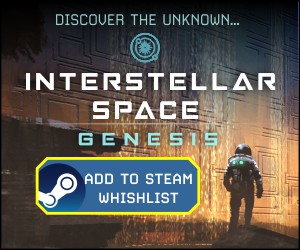
26 Comments
Related Articles:
- The Last Federation: Betrayed Hope Review
- The Last Federation – First Impressions
- TLF: The Lost Technologies Expansion – Impressions
- The Last Federation Giveaway Contest – 10 Keys! [CLOSED]
- The Last Federation Giveaway Contest! – 10 Keys [RESULTS]

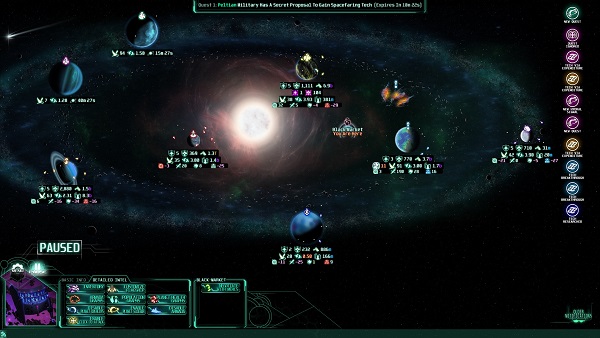
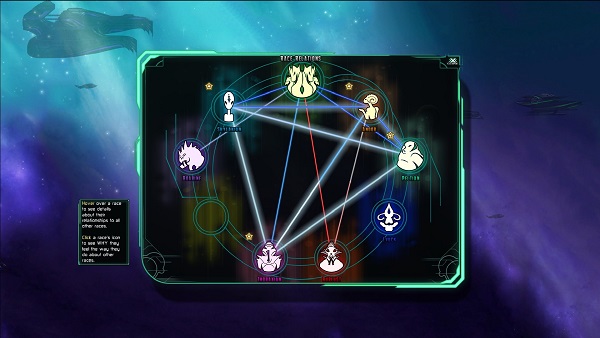
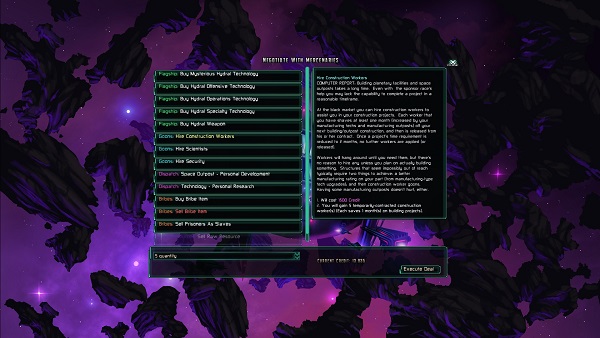
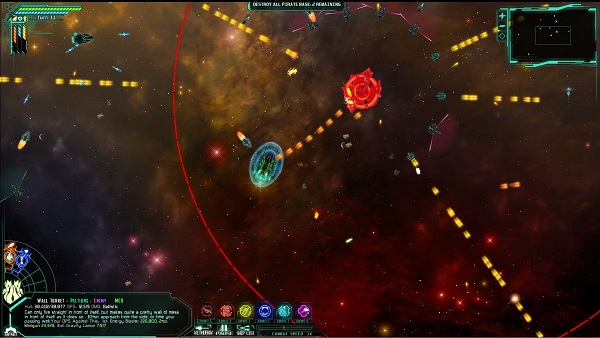
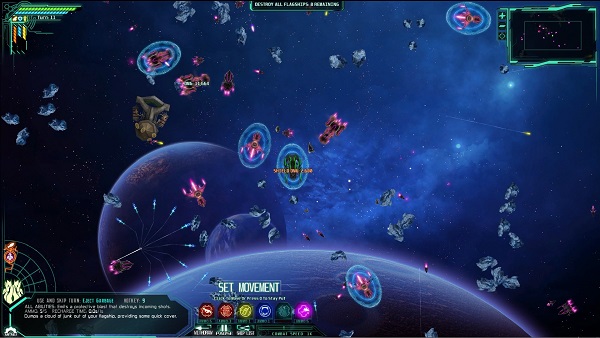
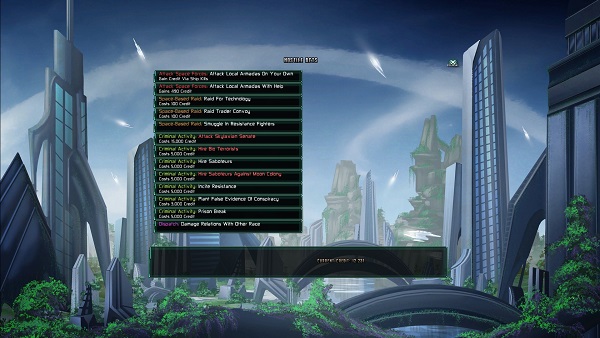
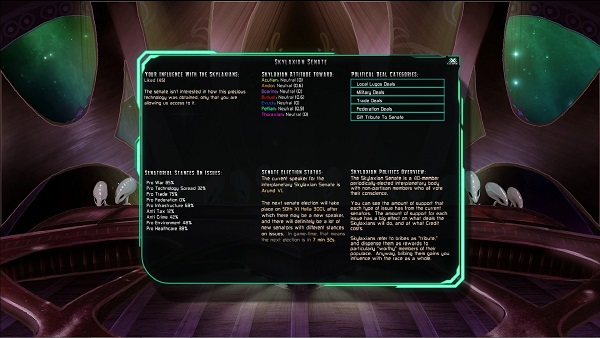
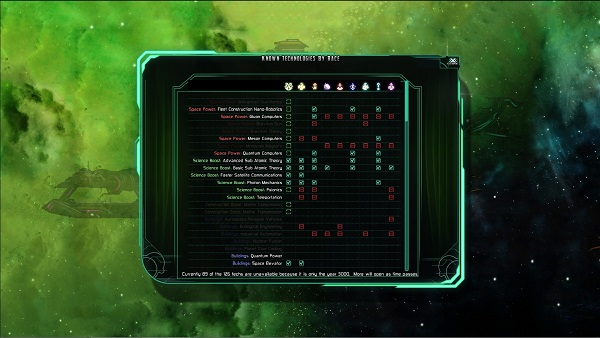
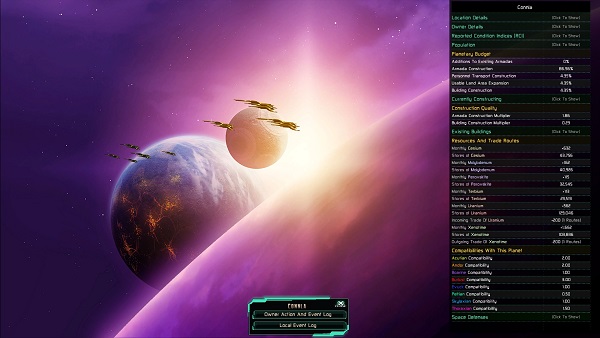
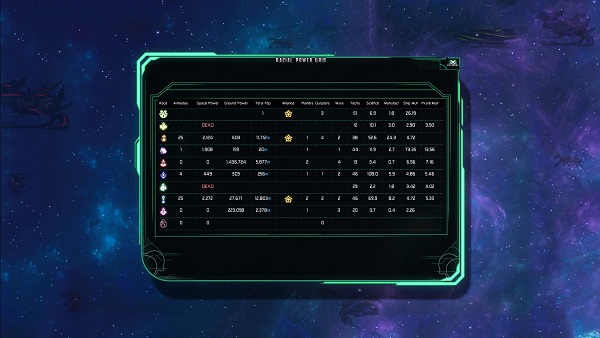
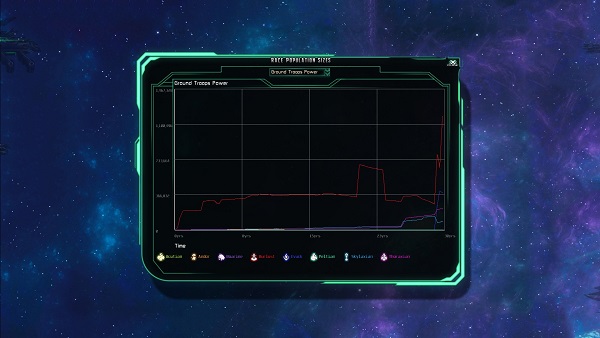
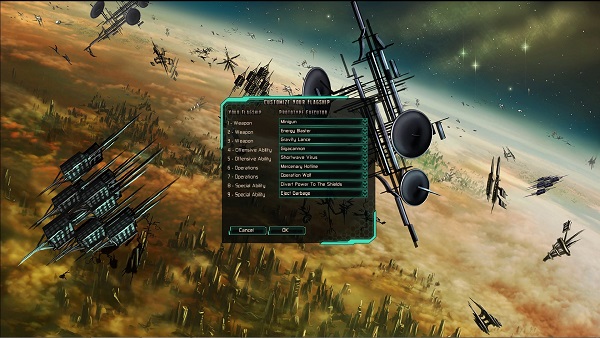

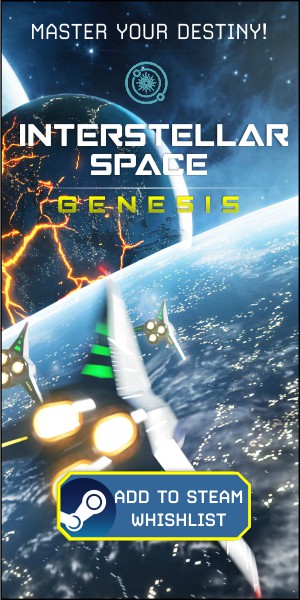
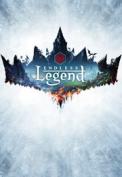

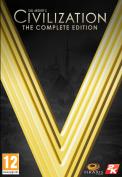


Haven’t played this one yet. Looks like I won’t anytime soon either. I’m not fan of games that plays themselves. Also the combat systems is real time WEGO/IGOUGO kind of thing which is unnecessary in 4x games.
It’s not really a 4X game. It has some elements that are in common with certain 4X games but it is not classified as such. Actually, it is hard to classify this game but Grand Strategy would be a closer one and it seems what most adverts for it use.
It probably has more in common with games like Crusader Kings 2 (but in space) than it does with let’s say Master of Orion.
We cover a lot more than just 4X games at SpaceSector. We are the home to strategy games. 4X is just the preferred type of strategy games for many of us and takes a big chunk of our focus, but we like the others too. :)
Personally, I do like the whole plan and execute style of tactical combat, but as I mentioned in the review I found that for this game it was more of a stop-motion shoot-em-up, which would leave actual tactical fans disappointed.
Games that did this mechanism better was Frozen Synapse and Leviathan: Warships, and do think there is a room for it in the space strategy and 4X genre if done as a true tactical combat system.
I have played TLF and this review hits it on the head.
Nice balanced review which goes into an impressive amount of detail to accurately depict the pros and cons of this rather unique game.
I really wanted to like Last Federation and spent quite a bit of time trying to do just that. Unfortunately I found it very repetitive, un-immersive and ultimately quite boring. I’ve since deleted it from my drive and haven’t really looked at it again. As the reviewer says though, some people might really like the game’s unusual style, I just don’t think I’m one of them.
I agree with almost everything in this review, beside one thing: “combat can get repetitive”. I meant the word “can”. Combat in this game is honestly more boring than killing mobs in average korean mmo grindfest.
Oh dear, that’s quite boring haha
I bought it, played it for 8 minutes.
yours
SamDog
It just doesn’t seem to be the type of engaging game that people are looking for.
The game seems to be very repetitive, the simulation was not well done, and the replay value isn’t looking too good.
In and of itself, repetitive combat is not always bad if it is well done (Ex: Shogun 2: Total War), but this game just doesn’t feel like its tactical layer was too well done.
You folks do realize this game is very succesfull in terms of sales. The fact that many of you ‘I wanna play yet yet another clone of MoO2 game’ do not like it does not mean it is a bad game. This game is doing very well and more content is being made for it.
Also as a side note: Arcen is working on a actual 4x game which they are calling Spectral Empire.
And no I am not part of Arcen or payed by them. I am just a customer of a few of their games and us hardcore gamers need more companies like Arcen, they actually do right by their customers with good support, with gamepatches and even additional content for acceptable prices.
“You folks do realize this game is very succesfull in terms of sales. The fact that many of you ‘I wanna play yet yet another clone of MoO2 game’ do not like it does not mean it is a bad game.”
Yes, but by the same token, just because a game has sold well doesn’t mean it’s for everyone, either.
Anyway, I too agree with this review overall. The Last Federation has its charms (and a good level of developer support), but I can also see how people who want a more traditional 4X experience would be left cold by it.
HappyCorner: “Yes, but by the same token, just because a game has sold well doesn’t mean it’s for everyone, either.”
That’s very true.
There is always room for improvement. I just think a lot of folks automatically put the stamp negative on a game if it does not fit the so called defacto standard. Especially in the space 4x genre.
It’s not even the 4X experience which will leave you let down. If your a fan of the Total War series, or Sins series, or any RTS series, it will leave you feeling drained with the game. It’s a weird and odd mix of different genres and styles that creates something that isn’t quite like anything it’s made up of.
And in going into it, expecting it to play like any one of those styles, you’ll feel slightly out of sync with the gameplay. Truth be told, even if you accept this Frankenstein monster of genre compilations, the gameplay is still off putting and will leave you, if not cold, then confused with gameplay experience.
Good sales != good game. The reviewer was not overtly harsh in his criticism of the game, however he does point out flaws that can be seen in the game very early on and only get worse as time goes on. 7 is still a very good score (seriously, check the scoring chart), but it does show that the game itself has flaws and that some of these flaws are not exactly fixable without major rewrites with expansions.
Some people will enjoy the game, and it’s unique style will definitely excite some people but I don’t think it’s unfair to point out the game leaves something to be desired especially if you prefer one genre over another.
Gmandam: “And in going into it, expecting it to play like any one of those styles, you’ll feel slightly out of sync with the gameplay. Truth be told, even if you accept this Frankenstein monster of genre compilations, the gameplay is still off putting and will leave you, if not cold, then confused with gameplay experience.”
Yes, but isn’t this very much your own expierence/feeling with the game? That does not mean the game is bad. You personally do not like it as you are comparing it with other games. Look at the game on it’s own right, it has no precedent. I understand what you are saying though. I just think folks automatically put the stamp negative on a game if it does not fit the so called defacto standard. Especially in the space 4x genre.
Gmandam: “7 is still a very good score (seriously, check the scoring chart)..”
I am old skool and do not believe in scoring a game. A game is not a test which has a ratio of right and wrong answers. I believe in a proper factual review describing the game, its mechanics, why gameplay happens the way it happens, and lastly what the expierence was playing it. And if the review is done well another person will also give their expierence and facts in a biline, perhaps that reviewer comes from another game genre, so providing multiple angles. Way back in the 90s this is how it was done in a certain magazines.
One of the reasons I read spacesector is because of the detailed written reviews. I sometimes find them to opinionated but I can read through that.
Incredibly thorough review! I wasn’t terribly impressed with TLF when it was released, and after Ed’s review, I’m SURE it isn’t my cup of tea. It obviously appeals to some people, is well supported and has good production values, but the premise is bizarre and the gameplay is exactly backward: real-time strategy, turn-based tactical.
No thanks.
JeffP: “… but the premise is bizarre and the gameplay is exactly backward: real-time strategy, turn-based tactical.”
Why would this be backward? Because it does not fit the known ‘standard’!
And why would the premise of this game be bizarre? I mean in this game you basically play as if you were the Shadows or Vorlons from Babylon 5 trying to manipulate other races, why is that bizarre, that is just an awesome idea. Now whether that idea is correctly executed is whole other debate.
The premise is certainly interesting and original, but something about the execution makes it very difficult for me to engage with this game or find any fun at all for that matter. And I spent quite a bit of time trying.
I’d be happy to admit it simply isn’t for me but as you say, the basic premise sounds amazing so I’m really not sure why I don’t like the game…… I suspect that the problem lies in the execution and mechanics which are just boring, lifeless and un-immersive.
As the article writer I need to clarify a few things.
First of all, a lot of the criticism I placed up on this title does not come from the fact it was not “traditional 4X”. Considering I spend more hours playing games like Crusader Kings (1 and 2), the Europa Universalis series, and the older Romance of the Three Kingdoms titles before Koei went all Dynasty Warriors; makes even the slightest insinuation of this in my review mildly offensive.
Personally I would adore a game like EU or CK set in space, over the next MOO or SMAC. Actually, I had very firm criticisms of SMAC and MMO2 even when I played them back then, views I still share today. Many of which I am certain will anger some of our readers since they are overtly harsh. Also, my background of games include those that will never see the light of day here at SpaceSector. My favourite title of all times is a JRPG (though my second favourite one was Star Control 2, but even that is borderline).
Now that the unpleasant part has been taken care off :). On to what I wanted to say.
Many of the criticism I levied against the game does not stem from it not being conventional, I even praise its originality but mention this may not be what some may want (and that is entirely correct). My role at that point is to try to convey those ‘anomaly’, if reading through it you feel that my statements are false or opinionated, I still did my job because you now know this game might actually interest you. A well written review can convey a reverse impression to a reader or watcher, and usually might even be more telling of the game when you don’t fully agree.
As I mention in the review, the game most certainly will appeal to some/many but also not appeal to others. Those who don’t like it is not because they don’t want to give it a chance, they just don’t like it. They may not express this disdain in the most elegant way or sound like they are narrow-minded in their tastes, but it is only on how they express their views. “Opening their eyes” would only change how they express their views, not actually change them.
The developer support and dedication to their game is admirable, and the game most certainly brings a lot to the table even if you are one of those that did not like it. However, I do feel the game contains two flaws that even if the game scratches your itch perfectly can’t be ignored. Just like how I will gladly point out the flaws of many ‘classics’ of this genre that I feel too many overlook.
I don’t regret buying this game and had a lot of fun with it actually. I even recommended it to a few of my friends. None of that changes what I say in my review. This is actually a positive review on my hand (not a glowing one, but a positive one none the less), I am very critical and even harsh to an extent in my review process.
Hopefully, this has clarified some things to our readers.
Thank You,
Edward.
Edward I do not understand why you felt the need to clarify yourself as I am not criticizing you or the review.
I am criticizing certain commenters, as I think they are too quick to brand the game ‘negative’ based on the fact it does not fit their imaginary defacto standard. I am not saying it is wrong that they like a certain playstyle or gamedesign.
I just expect more open mindedness from commenters if this genre which we love playing so much is ever to move forward from the 25+ years civ style game mechanics that are being copied/cloned over and over. And let’s face it a lot of these clones are not good. The games that move away from the civ style designs are doing better, take Distant Worlds for instance.
Yawn, another realtime spacesim game. No thanks, zero interest. There are enough of this out there.
After decades I am still waiting for the TRUE successor of a masterpiece like MOO2 was. (complete with turnbased tactical combat, turnbased strategic game and easy to learn, but hard to master, TRANSPARENT rules!)
Having played it, I’ll say that it doesn’t really feel like a real-time game. Unlike a true RTS game, there’s nothing in Last Federation that requires quick thinking or multitasking.
Both in the solar system map and the battles, the game doesn’t move until you make a decision. Then it only runs until you’ve finished doing whatever move you decided to do… and the only thing you can give orders to is your one spaceship. It feels more like a turn-based game (or even a board game) where a turn isn’t always the same length.
That said, if you’re waiting for the TRUE successor of MOO2, this game is obviously not what you’re looking for.
Yeah the combat actually *is* turn-based but as the reviewer has taken pains to point out it isn’t a 4x and doesn’t try to be.
Unfortunately whatever it is I don’t seem to find it very interesting. Either I’m not getting where the fun is or this crazy mish-mash of genres simply doesn’t work.
Not really. I’m a huge fan of Space RTS but I’ve not encountered one worthy of the title since Homeworld. Most either have 4x elements, nothing to sniff at considering my playtime on paradox games, but they aren’t true space RTS. The other variant is a sci-fi RTS, of which there are plenty, but most don’t touch the space aspect in any significant way at all.
Ironically, despite some of my issues with Planetary Annihilation, it’s actually the closest I’ve gotten to a proper Space RTS in a good long while. Which really says something about how I’m willing to lower my standards regarding the amount of space in my RTS.
Total Biscuit did a video review some time ago and I think he made an accurate assessment to the pros and cons of the game.
https://www.youtube.com/watch?v=iu1VziShzDg
I’m more of a MOO/SOTS person so I didn’t really like what I saw tbh.
Great review!
I agree, yet another fantastic review. In my travels around the Internet, I’m mentioning Space Sector reviews wherever possible, the team here deserve everything we can do as a community to help them.
Just wanted to say awesome review Edward! Hit it right on the head as far as the review! Nice to see that your reviews are still as through as they have ever been. Keep up the good work bud.